Portfolio: Carnegie Museum of Natural History - Part 1
- LutzR2

- Nov 18, 2023
- 5 min read
Updated: Nov 19, 2023
Exhibits Department - Preparator 1 Diorama Artist 1989 to 1998

I was in the Exhibits Department of the Carnegie Museum of Natural History for nearly fifteen years, not counting my time spent volunteering on projects. Though working for a non-profit meant earning low wages, I enjoyed the unique opportunity of participating in unique projects. The overarching goal of expanding the public’s knowledge on a variety of subjects stimulated my own creativity and curiosity. I began as a diorama artist, assisting in the fabrication of various components used in a variety of life size diorama displays.
Walton Hall of Ancient Egypt
In the upper two photos I am assisting Patrick Martin in moulding the face of an Egyptian model. The lower three are of the plaster, life sized mannequin that I was able to assist in sculpting while still an art student.
In 1989, while still a student at The Art Institute of Pittsburgh, I volunteered to help in the Exhibits Department. Patrick Martin was the lead artist and was sculpting two life sized Egyptians for a diorama that depicted the making of glass beads. On my first day I went into a studio that was kept very cold in order to slow down the curing of the plaster used in forming the figures. Mr Martin was quiet while he worked, only asking me a few questions. As he worked I began to anticipate what tools he’d be reaching for next and was able to hand them to him quickly. I remember that we didn’t speak very much at all as we focussed on our tasks.
The mannequin we worked on was missing its head, hands, and feet but was mostly “fleshed in” otherwise. It was basically down to refining its look in order to look like a real person. After hours of working in silence he asked me how I thought it looked. I honestly mentioned some slightly odd aspects of the form. He then handed me some calipers, pointed at the reference photos of the living model that had posed for this piece, and had me check dimensions. After showing him I was correct he then said, “I’m going on vacation for a while starting tomorrow. Have this done when I get back.”
It was an incredibly pivotal moment in my life as an artist, and helped set my mind to wanting to become employed at the Carnegie Museum.
Hall of African Wildlife

After graduating from art school I then spent a few years working in a variety of creative roles in the commercial, film, and set construction industry that was flourishing around Pittsburgh. In late 1992 I had another opportunity to volunteer at Carnegie, this time it led to employment. The project that brought me onboard was the fabrication of an acacia tree for the Hall of African Wildlife. The tree’s large trunk, and wider limbs had already been created. The main structure was steel rods welded together, covered with a wire mesh, and then an epoxy was used to cover the mesh. Texture moulds taken from actual acacia trees were then pressed into the epoxy as it set, giving the tree’s bark a lifelike quality.
My task was to fabricate and mimic the smaller branches, and thousands of thorns that form the canopy. I used a stiff wire garden fencing material, snipping it apart and then twisting it around the tree's metal branches. I also used foam pipe insulation, which I tapered down on one end using a belt sander, to make the medium sized branches. To mimic the already cast texture of the acacia bark I employed liquid nails, and then everything was painted, and dry brushed to match the colors of the living tree. I had hoped to make it have leaves, but there was just no time to actually produce the thousands of tiny leaves needed, so it was decided it would be a “dead” tree. I literally spent many weeks standing on a lift, well up in the branches working every single day. It wasn’t uncommon for staff to forget I was up there and I witnessed some unusual departmental drama at times.

Hall of North American Wildlife
The next diorama project I participated in was the Hall of North American Wildlife. We overhauled the old, poorly made and scientifically incorrect Kodiak bear diorama, and we repaired and cleaned the original wildlife dioramas.
These photos are of the original Kodiak bear diorama taken before it was disassembled.

The original Kodiak bear diorama was completely removed, the animals cleaned up, and the entire display rebuilt from scratch. I spent a lot of time making fake rocks and plants. For the grasses we used actual plants collected from Kodiak island. They were then soaked in a special preservative for a few months, and then dried out. After drying the grass then curled into a “straw,” so I had to literally iron them flat using starch to hold their shape. Each blade was then attached to a fine wire and painted. The wires stiffened them up and were placed in a mesh a few inches from the “ground” to give them a natural spacing. I also spent a lot of time hand cutting salmonberry leaves out of thin sheets of vacuum formed plastic.

In addition to helping with the complete overhaul of the Kodiak diorama I was also tasked with cleaning up and repairing the many, older dioramas that had been decades ago. This entailed cleaning of years of coal dust and grime from the mounted specimens and sets. There was also damage to many leaves of various plants, all made from wax, so it entailed careful use of hot needles to “weld” them together. We also added a variety of additional, small samples of wildlife, new “rocks” made from foam, and “snow” in certain winter settings. It was an interesting project so say the least.
Alcoa Foundation Hall of American Indians

In the late 1990’s I spent two years basically locked away in a large section of the museum with another scenic artist named Mark Barill. Together we enjoyed creating the various dioramas and displays for this very large exhibit. Of particular interest was the creation of the artificial Hopi house. In order to keep the structure light enough to be supported by the floors of the museum it was crafted from foam, paper mache, plaster, and other assorted lite materials. It took many months of work, but in the end it looks pretty real and is one of the central focuses of the hall.
In addition to the Hopi house diorama I enjoyed working on a number of other display components. It was a fascinating two year project. While working in this hall I was also attending evening and weekend classes in Computer Animation & Multimedia Design at the Art Institute.
Above I can picture applying a coat of paint to a life sized horse. It’s made from lots of foam over a metal skeleton, and covered with a layer of plaster. So much sanding was done!
Below are a few photos of the bison that is still on display in the hall. We acquired the animal from a friend of mine. After a sacred ritual involving a Lakota medicine person it was then killed, skinned, and the hide mounted after being cured with salt and then tanned.
We also cast a number of plaster heads using moulds made from actual native people. My job was to create the moulds used, and then casting the heads in plaster. I did not paint the final skin tones, which I have always felt was not very lifelike.
My favorite memories are not so much about the project itself but my time spent working with the talented scenic artist Mark Barill. In the two years that we worked together every day was simply enjoyable. I have never had such a good time working with another person. He not only made me laugh, but he also shared his knowledge of art history, and taught me many artistic skills that have stuck with me.























































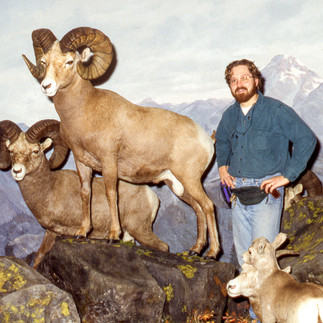

























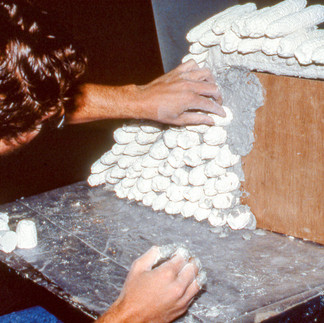










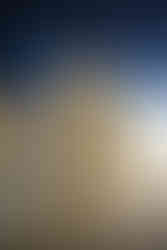





















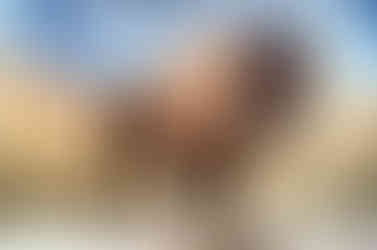






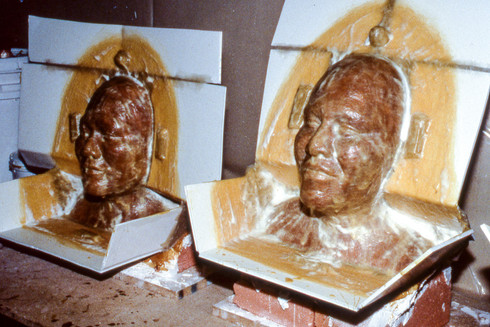


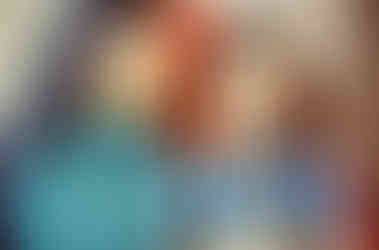




















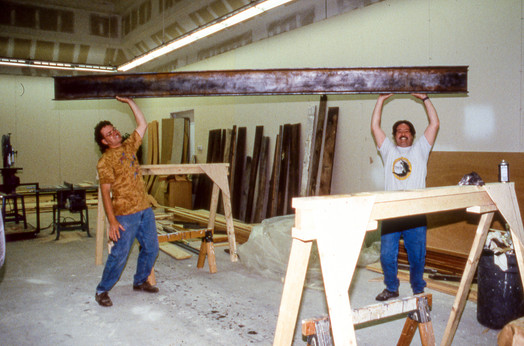











Comments